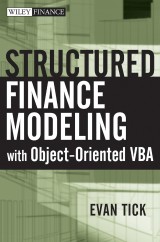Details

Structured Finance Modeling with Object-Oriented VBA
Wiley Finance, Band 390 1. Aufl.
|
CHF 51.00 |
|
| Verlag: | Wiley |
| Format: | |
| Veröffentl.: | 10.04.2007 |
| ISBN/EAN: | 9780470130414 |
| Sprache: | englisch |
| Anzahl Seiten: | 352 |
DRM-geschütztes eBook, Sie benötigen z.B. Adobe Digital Editions und eine Adobe ID zum Lesen.
Beschreibungen
<b>A detailed look at how object-oriented VBA should be used to model complex financial structures</b> <p>This guide helps readers overcome the difficult task of modeling complex financial structures and bridges the gap between professional C++/Java programmers writing production models and front-office analysts building Excel spreadsheet models. It reveals how to model financial structures using object-oriented VBA in an Excel environment, allowing desk-based analysts to quickly produce flexible and robust models. Filled with in-depth insight and expert advice, it skillfully illustrates the art of object-oriented programming for the explicit purpose of modeling structured products. Residential mortgage securitization is used as a unifying example throughout the text.</p>
<b>Preface.</b> <p><b>List of Acronyms.</b></p> <p><b>Acknowledgments.</b></p> <p><b>About the Author.</b></p> <p><b>Chapter 1. Cash-Flow Structures.</b></p> <p>1.1 Getting Started.</p> <p>1.2 Securitization.</p> <p>1.3 Synthetic Structures.</p> <p>1.4 Putting It All Together.</p> <p><b>Chapter 2. Modeling.</b></p> <p>2.1 Dipping a Toe in the Shallow End.</p> <p>2.2 Swimming Toward the Deep End.</p> <p>2.3 Types.</p> <p>2.4 Class Architecture.</p> <p>2.4.1 Weak Inheritance.</p> <p>2.4.2 Parameterized Class.</p> <p>2.4.3 Which Is Better?</p> <p>2.5 Exercises.</p> <p><b>Chapter 3. Assets.</b></p> <p>3.1 Replines.</p> <p>3.2 Portfolio Optimization.</p> <p>3.2.1 Zero-One Program.</p> <p>3.2.2 Simulated Annealing.</p> <p>3.3 Losses, Prepayments, and Interest Rates.</p> <p>3.4 Cash-Flow Model.</p> <p>3.4.1 Zero-Prepay Cash Flows.</p> <p>3.4.2 Actual Cash Flows.</p> <p>3.4.3 Examples.</p> <p>3.5 S&P Cash-Flow Model.</p> <p>3.5.1 Model Parameters.</p> <p>3.6 Moody’s Cash-Flow Model.</p> <p>3.6.1 Model Parameters.</p> <p>3.6.2 Algorithm.</p> <p>3.7 Option ARMs.</p> <p>3.8 Class Architecture: Multiple Inheritance.</p> <p>3.9 <i>Doing It in Excel</i>: SumProduct.</p> <p>3.10 Exercises.</p> <p><b>Chapter 4. Liabilities.</b></p> <p>4.1 Getting Started.</p> <p>4.2 Notation.</p> <p>4.3 Expenses.</p> <p>4.4 Interest.</p> <p>4.5 Over-collateralization.</p> <p>4.5.1 Current Subordinated Amount.</p> <p>4.5.2 Stepdown Date.</p> <p>4.5.3 Target Subordinated Amount.</p> <p>4.6 Principal.</p> <p>4.6.1 Gross Principal Distributions.</p> <p>4.6.2 Detailed Principal Distributions.</p> <p>4.7 Writedowns and Recoveries.</p> <p>4.8 Derivatives.</p> <p>4.8.1 Corridors.</p> <p>4.8.2 Swaps.</p> <p>4.8.3 Excess Reserve Fund Account.</p> <p>4.9 Triggers.</p> <p>4.9.1 Call Features.</p> <p>4.9.2 Overcollateralization Test.</p> <p>4.9.3 Interest Coverage Test.</p> <p>4.9.4 Delinquency Trigger.</p> <p>4.9.5 Loss Trigger.</p> <p>4.10 Residuals: NIMs and Post-NIM.</p> <p>4.11 Class Architecture.</p> <p>4.11.1 Passive Approach.</p> <p>4.11.2 Active Approach.</p> <p>4.11.3 Comparison.</p> <p>4.12 <i>Doing It in Excel:</i> Data Tables.</p> <p>4.13 Exercises.</p> <p><b>Chapter 5. Sizing the Structure.</b></p> <p>5.1 Senior Sizing.</p> <p>5.2 Subordinate Sizing.</p> <p>5.2.1 Fully Funded vs. Non–Fully Funded.</p> <p>5.3 Optimizations and Complexity.</p> <p>5.4 Example of Sizing.</p> <p>5.5 NIM and OTE Sizing.</p> <p>5.6 Class Architecture.</p> <p>5.6.1 Inheritance Revisited.</p> <p>5.6.2 Odds and Ends.</p> <p>5.7 <i>Doing It in Excel</i>: Solver.</p> <p>5.8 Exercises.</p> <p><b>Chapter 6. Analysis.</b></p> <p>6.1 Risk Factors.</p> <p>6.1.1 Prefunding.</p> <p>6.1.2 Prepayments.</p> <p>6.1.3 Buybacks and Cleanup Calls.</p> <p>6.1.4 Defaults.</p> <p>6.1.5 Interest Rates.</p> <p>6.1.6 Spreads.</p> <p>6.1.7 Miscellaneous.</p> <p>6.1.8 Residual Sensitivities.</p> <p>6.2 Mezzanine and Subordinate Classes.</p> <p>6.3 NIM Classes.</p> <p>6.4 Putting It All Together.</p> <p>6.5 Exercises.</p> <p><b>Chapter 7. Stochastic Models.</b></p> <p>7.1 Static versus Stochastic.</p> <p>7.2 Loss Model.</p> <p>7.2.1 Probability of Default from Transition Matrix.</p> <p>7.2.2 Probability of Default from Spread.</p> <p>7.2.3 Probability of Time to Default.</p> <p>7.3 Gaussian Copula.</p> <p>7.4 Monte Carlo Simulation.</p> <p>7.5 Synthetic Credit Indexes.</p> <p>7.5.1 Loss Lets.</p> <p>7.5.2 Analysis.</p> <p>7.5.3 Hedging.</p> <p>7.6 <i>Doing It in Excel</i>.</p> <p>7.7 Exercises.</p> <p><b>Appendix A. Excel and VBA.</b></p> <p>A.1 Spreadsheet Style.</p> <p>A.2 Code Style.</p> <p>A.3 Compilation.</p> <p>A.4 Bloomberg.</p> <p><b>Appendix B. Bond Math.</b></p> <p>B.1 Mortgage Payment.</p> <p>B.2 Yield to Price.</p> <p>B.3 Price to Yield.</p> <p>B.4 Duration.</p> <p>B.4.1 Index or Interest-Rate Duration.</p> <p>B.4.2 Discount Spread Duration.</p> <p>B.5 Hazard Rate.</p> <p>B.6 Static Credit Card Model.</p> <p><b>References.</b></p> <p><b>Index.</b></p>
<b>Evan Tick</b> is a director at IXIS Capital Markets, and has worked on Wall Street for ten years. His expertise is fixed income and structured finance modeling in the areas of risk management, asset-backed securities (ABS), residential mortgages, and credit derivatives.
<p>Praise for STRUCTURED FINANCE MODELING with Object-Oriented VBA</p> <p>"This book is an excellent and interesting integration of financial engineering, structured finance, and structured programming, and the book accomplishes this with easy-to-follow examples, using the most commonly available tools, MS VBA and spreadsheets. The author is clearly intimately familiar with structured products, the mechanics and challenges of securitization, and the financial and analytical modeling that is required to understand and manage these diverse financial products. The result is a book that demonstrates an easy-to-follow combination of finance and object-oriented programming. This is a 'must own book' for the active practitioner, the financial engineer on the front lines of the structuring battle."<br /> —Cyrus Mohebbi, PhD, Head of MBS/ABS Structuring and Analytics, HSBC Securities Inc.</p> <p>"Tick has written a seminal structured finance book. He presents an approach to modeling that is both efficient and practical. His work will serve as a timeless template to simplify the complexity of structured finance."<br /> —Janet Tavakoli, President, Tavakoli Structured Finance</p> <p>"Dr. Tick's experience in applying theoretical concepts to various markets is well encapsulated in this book. A must-read for technicians and market practitioners alike who would like insight into practical solutions to complex financial modeling problems."<br /> —Adil Nathani, Old Lane Management</p> <p>"Reading Tick's book gives a real-world introduction to practical bond structuring, the activity that generates a significant part of Wall Street's profits. This book from a (financial) engineer who is intimately involved in this business, gives the details needed to generate accurate cash flows along with meticulously presented real-life examples. In addition to meat-and-potatoes asset and liability cash flows, he discusses optimization and stochastic modeling, a useful introduction to synthetic structures. This book also serves as an introduction to programming skills in VBA."<br /> —Ramine Rouhani, Managing Director, Head of Capital Markets, IXIS Capital Markets North America</p>
Diese Produkte könnten Sie auch interessieren:

Entwicklung und Vermarktung innovativer Finanzprodukte

von: Dieter Krimphove, Christoph Lüke

CHF 70.00
















